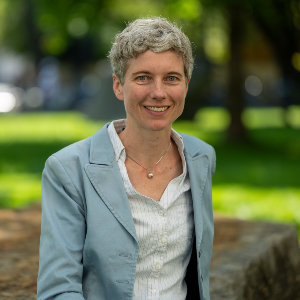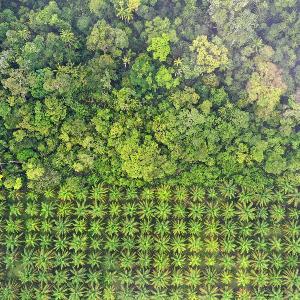Climate protection: “The forest is our greatest ally”
10 Sept 2025
The forests in Germany are suffering. In our interview, LMU geographer Julia Pongratz explains what this means for Germany’s prospects of reaching its climate targets.
10 Sept 2025
The forests in Germany are suffering. In our interview, LMU geographer Julia Pongratz explains what this means for Germany’s prospects of reaching its climate targets.

Climate expert Julia Pongratz | © LMU
Professor Julia Pongratz heads the Chair for Physical Geography and Land Use Systems at LMU's Faculty of Geosciences. She was recently appointed to the German Council of Experts on Climate Change and is a member of the Scientific Advisory Board for Natural Climate Protection (Wissenschaftlicher Beirat für Natürlichen Klimaschutz).
The Climate Action Act stipulates that Germany must be greenhouse gas neutral by 2045. This means that in 20 years’ time, we must not be emitting more greenhouse gases than we are sequestering.
What role does land use play here?
Julia Pongratz: Land use and the management of ecosystems play a special role in the Climate Action Act, because this is the only area in which CO₂ can potentially be sequestered. Although other sectors like industry, transport, and building can strongly reduce their emissions, there would be residual emissions even if all their energy were to come from renewable sources. To become greenhouse gas neutral by 2045, these emissions must be offset. The land use sector is predestined for this role, as virtually all carbon removal worldwide currently takes place in this area. Greenhouse gas neutrality can be achieved only when we reduce emission sources while also preserving and strengthening existing sinks.
So the land use sector can sequester more greenhouse gases than it emits?
The two biggest CO2-fluxes in land use in Germany are emissions from drained peatlands and carbon uptake by forests. In Germany, massive amounts of carbon – around 50 million metric tons of CO₂ every year – are emitted from peatlands that have been drained for agricultural use. For a long time, these emissions were balanced out or even overcompensated by forests.
The forest is our greatest ally in climate protection. Globally, it absorbs between a third and a quarter of human CO₂ emissions every year – a free ecosystem service. Without these natural sinks, which include the oceans as well as forests, climate change would be twice as strong.
The “Land Use, Land Use Change and Forestry” (LULUCF) sector encompasses various forms of land use and ecosystem management, including forestry. It excludes agriculture, which is recorded separately.
We need more forest, then?
More area for close-to-nature forest ecosystems helps with carbon storage. The objection is often raised that this use competes with food production or pasture areas. In fact, we could free up a lot of land area if we changed our production and consumption in the direction of healthier diets and plant-based foods. This would be a win-win situation in matters of health and climate action.
Another climate friendly measure is the extensification of forest areas. If we allow forests to mature, they reach a high carbon density. We can increase the storage effect even further if we remove timber and use it in long-lasting products. But we need to use this resource carefully: If we remove too much, the carbon density declines. The composition of the forests is another factor. Spruce monocultures are extremely susceptible to disturbances. Broadleaf and mixed forests are much more robust against extreme weather and therefore more reliable CO₂ reservoirs. Old beech forests in particular should be used less intensively, as they sequester carbon over longer periods.
Many people assumed that forests would remain a reliable carbon sink, but events have proved otherwise.Julia Pongratz
German forests have suffered serious damage in recent years. What has happened to them?
Over the past few years, Germany’s forests have changed from being an important carbon sink to becoming a massive source of carbon emissions. The principal cause of this is the drought years from 2018 onwards, which weakened German woods and made them more vulnerable to pests like the bark beetle. Drought, heat, and insect infestation had devastating consequences, especially for spruce populations in places like the Bavarian Forest and the Harz Mountains. But beeches and oaks have also incurred considerable damage.
The extreme weather events of 2018 and subsequent years have turned the land use sector on its head. Dead trees do not sequester any new CO₂ and release their stored-up carbon as they decay. In the 1990s, forests were still a net sink of around 70 million metric tons of CO₂ per year. In 2023, by contrast, they emitted the equivalent of 20.9 million metric tons of CO₂.
Does this mean Germany can no longer depend on forests to protect the climate?
Many people assumed that forests would remain a reliable carbon sink, but events have proved otherwise. Although we can regenerate forests through suitable measures, the fact is that existing damage will not disappear overnight. It takes a very long time – decades to centuries – for forests to recover from such destruction. We’ll continue to record high emissions from the damaged stands over the coming years and decades. At some stage, forests will hopefully have regenerated to the extent that they once again sequester more CO₂ than they emit.
Will this cause difficulties for Germany in meeting its climate targets for 2045?
According to the Climate Action Act, the land use sector is supposed to save an additional 40 million metric tons of CO₂ equivalent a year by 2045. But since this target was fixed, the situation has fundamentally changed. Today, the only sector that was meant to be a sink is actually emitting CO₂ in large amounts. The projections clearly show that we will not reach the values set for the land use sector and that a huge chasm is opening up here.
The new Climate Action Act of 2024 is built upon a general consideration of the greenhouse gas emissions of all sectors. If you assume that the land use sector represents a carbon sink, then you can soften the targets in other sectors. So you could offset with forestry the targets you may have missed in transport, say, or in agriculture. The new data on the state of the forests show that this is an illusion.
It’s not about asking whether we can afford climate protection – it’s the only thing we can afford, as everything else will be more expensive.Julia Pongratz
What does this mean for climate protection?
Above all, that Germany must swiftly achieve lasting reductions of emissions in all areas. In particular, the transport and building sectors, which are currently still missing their climate targets, must implement significantly more ambitious measures. Because we’ll not be able to lean on the forests anymore in the short to medium term.
You often hear that Germany can do little to save the world’s climate, with just two percent of global emissions. But two percent caused by one percent of the world’s population is a lot – and Germany has a particular responsibility as the third largest national economy and as a country that has historically benefited massively from the use of fossil energy sources and contributed to climate change.
And at the same time we have to extract greenhouse gases from the atmosphere?
Yes, it is crucial to create, maintain, and preserve natural carbon sinks. This includes increasing forest area and making the transition to climate-resilient, biodiverse forests with high proportions of broadleaf trees. Forestry should be adapted – for example, through extensification in low-risk locations. In addition to forests, we also have to include other land areas, especially peatlands. In the recent expert report of the Scientific Advisory Board for Natural Climate Protection, we recommend rewetting around 80 percent of German peatlands by 2045. This will help reduce emissions in particular, but building up organic soils will also store carbon again in the long term.
Technical solutions are also needed: Recently the German government enacted an amendment to the Carbon Dioxide Storage Act. This will pave the way for the establishment of carbon transport and storage infrastructure in Germany. Given that we will not achieve net zero with forests alone, we need technical sinks to balance out unavoidable residual emissions. However, this should not deceive us into supposing we can offset unambitious emissions reductions with technical carbon storage solutions.
How can we reconcile the requisite political measures with economic interests?
I think it’s a major misunderstanding in the communication of climate policy to present climate protection purely in terms of costs. Studies show that the costs of climate damage if no climate action is taken will be much higher worldwide than the costs of emission reduction measures.
There is a sweet spot for minimal overall costs, which lies in the range of the Paris Agreement, at around 2 degrees of global warming. From an economic perspective, this is the most cost-effective. So it’s not about asking whether we can afford climate protection – it’s the only thing we can afford, as everything else will be more expensive.
Germany is one of 22 countries in which the economy has grown over the past ten years while CO₂ emissions have fallen – so it’s possible to decouple emissions from economic growth.Julia Pongratz

Palm oil plantation on the edge of the rainforest | © Richard Carey / stock.adobe.com
We’ve spoken about German forests. What is the global outlook?
Forests are in crisis throughout the world. In many regions of Europe, forest fires are increasing, becoming more extreme and more frequent. In 2023 and 2024, there were large droughts and devastating fires in Canada. And there were heatwaves and droughts in South America, too, where the rainforests are additionally endangered from advancing deforestation.
Over half of global land use emissions come from just three countries: Brazil, Indonesia, and the Democratic Republic of the Congo. A large portion of the deforestation there is for the production of soybean, meat, and palm oil, which are exported to the Global North and to China. Around a quarter of global land use emissions are generated for export to other countries. This gives us direct levers here in the Global North for influencing global climate change in other countries.
Back to German climate targets: Are they still obtainable?
It’s difficult to be upbeat when the current situation is so critical. On the other hand, it’s clear what has to be done – indeed, we’re doing it already, just too slowly: Germany is one of 22 countries in which the economy has grown over the past ten years while CO₂ emissions have fallen – so it’s possible to decouple emissions from economic growth.
When it comes to climate protection, many things are a question of political and social will. Here, it shouldn’t be a debate about giving things up, but about identifying and promoting the major synergies that climate protection can bring about for nature conservation, health, and a livable environment.